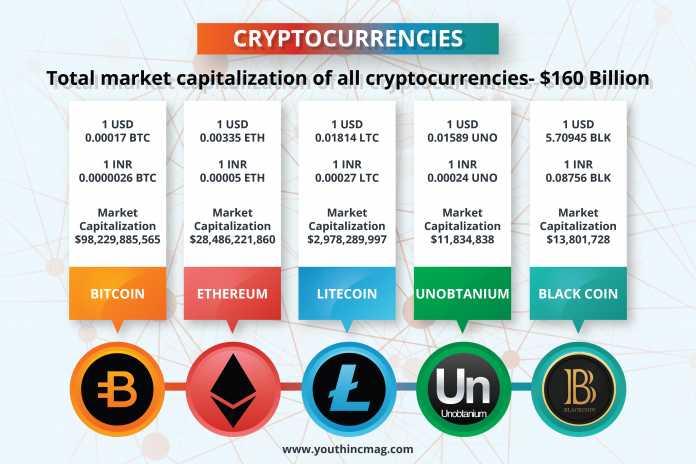In the 80’s and 90’s, there was a buzzword that was associated with the tech industry- the ‘dotcom’ bubble. Far before the Internet had penetrated into homes and palms of individuals, the ‘dotcom’ was a mysterious phenomenon that confused most people, and a many people considered it to be a trend wave. Only a few realized the tsunami that it really was, and history is repeating itself as the rise of cryptocurrency follows a similar pattern. Crypto-currencies are units of value that exist solely online.
Traditionally currencies are valued based on assets like gold, policies of banks and governments or other regulating bodies. However in the case of crypto-currencies, no such regulating agency or assets are in place, essentially the value of the crypto-currency is determined by the marketplace and the users itself. The words “ de-centralized”, “blockchains” and “ open ledger” are often attached to crypto-currencies, and there is a lot of anonymity in this world that promises transparency. It’s a complicated space to figure out, and even more complicated to be a player in.
Bitcoins, Litecoins, Blackcoins are few of the various crypto-currencies that exist currently, Bitcoin being the most popular one.
Bitcoins
The most famous brand of digital currency, Bitcoin is as mysterious as it is famous, or infamous depending on who you ask. At a current exchange rate of 3,70,000 INR (that is over ($5000 USD) the value of Bitcoin has grown at 750% in just one year.
Despite its high value, Bitcoin continues to be one of the most actively used digital currencies; in 2017 alone up to 300,000 transactions per day have been made. It first launched in 2009 and since then numerous other crypto-currencies have emerged in the virtual market, some of these are Litecoin, Ripple, Zcash, Ubiq, blackcoin, Ethereum, and Bitconnect. As a forerunner in this bizarre market, Bitcoin remains to be the most popular type of digital currency worldwide. Although most brick and mortar stores are unlikely to accept this type of payment, a lot of e-commerce websites, especially in the US are adapting to accept payment in bitcoins. Overstock, Expedia and Shopify are some examples, and companies like Microsoft and Dell have also made it possible for users to purchase games, apps, and videos by adding money to their accounts via Bitcoins.
Fact: Bitcoin is the original cryptocurrency with the most liquidity and significant network effects. It also has brand name recognition around the world, with an eight-year track record.
Ethereum
Ethereum, perhaps the second most popular type of crypto-currency, Ethereum is primarily used to fulfill transactions between users, that is peer to peer transactions. Ethereum is slowly inching up to Bitcoin.
Fact: Ethereum serves a different purpose than other cryptocurrencies, but it has quickly grown to displace all but Bitcoin in value. Some experts are so bullish on Ethereum that they even see it becoming the world’s top cryptocurrency in just a short span of time – but only time will tell.
Litecoin
Before Etherum took its spot, Litecoin operated in a very similar capacity to its contemporaries. It is possible to conduct smaller transactions in shorter amounts of time using Litecoin, making it possible for more people to participate using smaller amounts of coins in quicker transactions.
Fact: Other altcoins have taken away some of Litecoin’s market share, but it still has an early mover advantage and some strong network effects.
Unobtanium
With a cap limit of 250,000 coins, Unobtanium allows users to trade within this capacity and had a decent value initially, although this fluctuates. A key element to consider in the world of cryptocurrencies is mining. There are a finite number of coins that exist in the crypto-currency framework (be it Bitcoin, Litecoin, Black coin etc) however to “mine” these coins is extremely strenuous. Much like gold mining, mining Bitcoins (and others) requires patience and skill. Complex algorithms that get more difficult with each attempt limit the process of mining and this is also a contributing factor to the rising value of cryptocurrencies.
Fact: Since Unobtanium is merged with Bitcoin, it is a secure high-difficulty blockchain that is three time faster than Bitcoin. Unobtanium is rare not only in the number coins issued, but also in its fair launch and distribution
Black Coin
Launched in 2014 by a founder named Rat4, Blackcoin is another open-source crypto currency that is peer to peer based. With a shorter conformation time compared to Bitcoin, transactions using Blackcoin can be completed much faster. Since anonymity is a bit component in the digital currency space, almost always the creators of the currencies use alias identities and pseudonyms. Little information is available on who is manning the mechanisms behind the scenes.
Fact: Black Coin relies on a proof-of-stake system in order to verify transactions. This means that users stake coins from their wallets on the right to verify the next transaction. Those who are able to stake the most coins win the right to verify the next transaction. There is also an incentive to report the right results – if the transactions they try to verify doesn’t match what gets accepted by the system, those coins are lost.
The rules for digital currency are ever changing and expanding, and for most people this is a daunting space to understand let alone invest in. Many people wonder if digital currency will self-destruct or if it will come crashing down as speedily as it skyrocketed. Others continue to see it as just the beginning of a new way to make transactions. Unlike the ‘dot com’ bubble, there is little transparency for the average person to understand and participate in the marketplace of crypto-currencies, and with no attachment to governments and banks there is really no way to have assurance on your investment.































